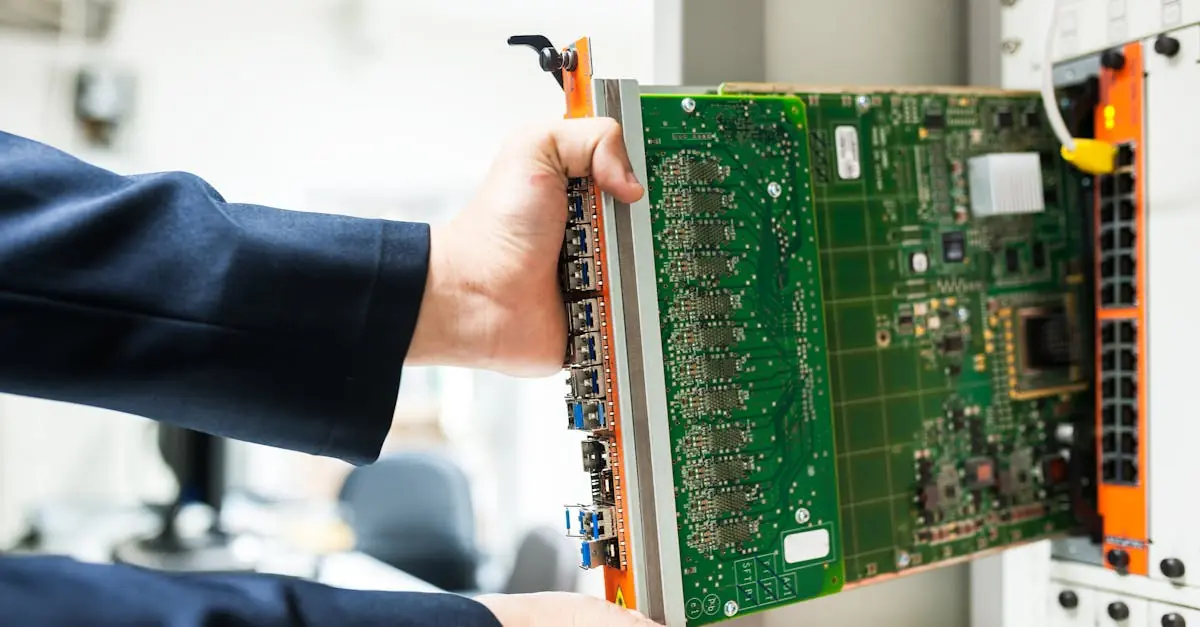In today’s fast-paced digital world, a reliable broadband connection isn’t just a luxury—it’s a necessity. Picture this: you’re ready to binge-watch the latest season of your favorite show, and suddenly, your internet decides to take a nap. Frustrating, right? That’s where a solid broadband system maintenance checklist comes into play.
Table of Contents
ToggleImportance of Broadband System Maintenance
Maintaining a broadband system ensures a reliable internet connection. Downtime impacts productivity and user experience significantly. Regular maintenance helps prevent issues before they arise, reducing repair costs.
Monitoring performance metrics like speed and uptime creates insights into system health. These metrics guide necessary upgrades or adjustments to enhance service quality. Regular checks of hardware components like routers and cables are essential. Faulty hardware often leads to interruptions and poor connectivity.
Routine software updates protect the system against vulnerabilities. Cybersecurity threats continue to evolve, making timely updates critical. Conducting regular system diagnostics identifies potential weaknesses.
User satisfaction relies heavily on a consistently stable internet connection. High satisfaction levels result from minimal disruptions during streaming or video calls. Consistent service allows for more effective work-from-home arrangements.
Addressing network congestion through system configuration enhances performance. Prioritizing bandwidth for high-demand applications improves user experience. Collaborative monitoring across all network users ensures peak performance.
A comprehensive maintenance checklist promotes accountability among team members. Clear documentation tracks completed tasks, ensuring nothing is overlooked. Maintenance not only extends equipment lifespan but also improves the overall user experience.
A proactive approach to broadband system maintenance guarantees optimal performance and user satisfaction. Adherence to maintenance schedules proves critical in an increasingly connected world.
Key Components of a Broadband System
Maintaining a robust broadband system relies on several key components. Understanding these elements ensures optimal performance.
Network Equipment
Routers play a crucial role in managing network traffic. Switches connect devices and improve communication efficiency. Access points extend Wi-Fi coverage, enhancing connectivity in larger areas. Firewalls protect against unauthorized access, safeguarding sensitive data. Regularly updating firmware for these devices strengthens security and performance. Tracking equipment performance metrics, like latency and packet loss, helps identify issues early.
Cabling Infrastructure
Cabling forms the backbone of any broadband system. Fiber optic cables support high-speed data transmission, while Ethernet cables connect devices within a local network. Ensuring proper cable management prevents interference and damage. Checking for signs of wear or degradation on cables maintains signal integrity. Furthermore, verifying that all connections are secure reduces the risk of service interruptions. Proper labeling of cables fosters easier troubleshooting and maintenance.
Broadband System Maintenance Checklist
A comprehensive checklist ensures the broadband system maintains optimal performance. Key tasks include regular inspections, performance monitoring, and firmware updates.
Regular Inspections
Inspections play a vital role in maintaining broadband systems. Technicians should regularly check hardware components, including routers and switches, for wear. It’s essential to visually inspect connections for signs of damage or corrosion. Scheduled inspections help identify potential issues before they escalate. Checking the physical environment for obstructions also enhances performance. Clean equipment and ensure proper ventilation to prevent overheating. Monitoring cable integrity, labeling, and organization should remain priorities during these inspections.
Performance Monitoring
Performance monitoring enables proactive maintenance of broadband systems. Tools such as network analyzers track speed, latency, and uptime to assess network health. Data collection allows for identifying trends in performance over time. Technicians should regularly review metrics to pinpoint bottlenecks or irregularities. Response times can also indicate congestion issues. It’s crucial to analyze these trends before they impact user experience. Regular monitoring allows for timely adjustments and capacity planning for future needs.
Firmware Updates
Updating firmware is critical for security and performance. Technicians must regularly check for software updates for all network equipment. These updates protect against vulnerabilities and improve device functionalities. It’s important to implement updates systematically, documenting each change. Scheduled updates minimize disruptions while keeping the system stable. Ensuring compatibility with existing hardware is essential during this process. Benefits include enhanced security features and improved performance efficiencies.
Troubleshooting Common Issues
Encountering issues with broadband connectivity can disrupt daily activities. Identifying and addressing these problems swiftly enhances user experience.
Connectivity Problems
Connectivity problems can stem from various sources. Loose cables often cause intermittent connections. Checking for secure connections at the router, modem, and wall can help resolve issues. Network overload can also lead to dropped connections; reducing the number of connected devices may alleviate strain. Additionally, interference from other electronic devices can disrupt signal strength; relocating routers may improve performance. Lastly, ensure that all equipment, including routers and modems, is powered on and functioning correctly.
Speed Issues
Speed issues can frustrate users, impacting online activities like streaming or video conferencing. First, running a speed test provides a benchmark for current performance. Comparing results against the subscribed speed plan can identify discrepancies. Upgrading older equipment can lead to better speed; investing in modern routers often improves connectivity. Checking for software updates ensures the latest features and optimizations are utilized. Furthermore, background applications running on connected devices can consume bandwidth; closing unnecessary apps can boost overall speed.
Best Practices for Effective Maintenance
Routine checks on broadband system components ensure a stable connection. Inspect hardware elements like routers, switches, and access points regularly to spot wear and tear early. Securing cables and ensuring proper cable management minimizes potential issues. Perform firmware updates consistently; these updates enhance both security and functionality, keeping the system in top shape.
Utilizing performance monitoring tools helps track network speed, uptime, and latency effectively. Network analyzers provide valuable insights, allowing for adjustments that preemptively address potential bottlenecks. Inspect data logs periodically; reviewing these logs can reveal patterns that indicate underlying problems. Document all maintenance activities; maintaining a detailed record assists in troubleshooting future issues.
Sharing best practices among team members fosters a culture of accountability. Formulate a maintenance schedule that includes specific tasks and timelines to ensure nothing is overlooked. Establishing clear communication channels allows team members to report issues or ask questions promptly, boosting response times.
Keeping up with industry trends and new technologies supports system enhancement. Regular training for staff on new tools or protocols ensures they remain effective and knowledgeable. Setting reminders for critical tasks, such as cable inspections and security assessments, keeps maintenance on track. Prioritizing these practices guarantees a reliable broadband experience for all users.
Conclusion
A well-maintained broadband system is vital for ensuring a seamless online experience. By following a comprehensive maintenance checklist, users can proactively address potential issues before they escalate. Regular inspections, performance monitoring, and timely firmware updates play crucial roles in maintaining system integrity and security.
Implementing these best practices not only enhances connectivity but also boosts user satisfaction. As technology continues to evolve, staying informed about the latest trends and tools is essential for ongoing success. Prioritizing broadband system maintenance will lead to a more reliable and enjoyable internet experience for everyone involved.








